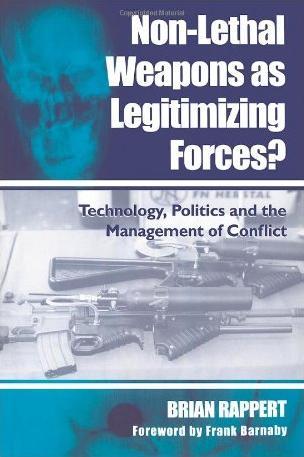 The legitimacy of the use of force by the police and the military often generates significant debate. In recent years there has been a re-emerging interest in so-called ‘non-lethal’ or ‘less-lethal’ weapons: equipment supposed to minimize or at least reduce the severity of injury in comparison to other options. While items such as plastic bullets, chemical irritant sprays, and electroshock equipment still dominate available non-lethal options, the future is supposed to bring a diverse array of acoustic, electromagnetic, biological, and chemical devices.
The legitimacy of the use of force by the police and the military often generates significant debate. In recent years there has been a re-emerging interest in so-called ‘non-lethal’ or ‘less-lethal’ weapons: equipment supposed to minimize or at least reduce the severity of injury in comparison to other options. While items such as plastic bullets, chemical irritant sprays, and electroshock equipment still dominate available non-lethal options, the future is supposed to bring a diverse array of acoustic, electromagnetic, biological, and chemical devices.
My research has often suggested the need for skepticism regarding the purported benefits of this class of weaponry. While not wishing to completely dismiss the potential of alternative force options to help realize more preferable outcomes, the deployment of non-lethal weapons raises various grounds for concern.
Their applications and contexts of use are multiple and not always foreseeable, and the manner of their use does not always result in minimal injury. Moreover, though many states and corporations boast about the robustness of their safety testing procedures and the strict rules in place governing the use of force, past experience across many countries indicates such statements should be approached with some caution.
There is a key question at stake in such developments: what does it means to claim that the problems associated with the acceptability of the use of force can be ‘solved’ through this application of technology? This question has been at the center of much of my research.
Policing and Evidence Group
With colleagues at the University of Exeter, I organize the Policing and Evidence Group (PEG), where we run a project specifically looking at the ‘Taser’ electroshock weapon.
Selected Publications
(For a complete listing of my publications click here)
- Dymond, A. and B. Rappert. 2015. The Role of Civil Society in the Control of New Weapons Technologies. Sicherheit und Frieden 2: 73-8.
- Dymond, A. and B. Rappert. 2014. Policing Science: The Lessons of Taser. Policing: A journal of policy and practice 8(4): 330-338.
- Rappert, B. 2008. Police Use of Force. In: Newburn, T. and P. Neyroud (eds) Dictionary of Policing. London: Willan.
- Rappert, B. 2007. Policing & the Use of Force. Policing: A Journal of Policy and Practice 1(4): 472-484.
- Rappert, B. 2004. A Framework for the Assessment of Non-Lethal Weapons. Medicine, Conflict and Survival 20: 35-54.
- Rappert, B. 2004. Shock Tactics. Police Professional 19 November 2004: 15.
- Rappert, B. 2004. Submission to the Northern Ireland Office and Home Office January 2004 Patten Recommendations 69 and 70 Relating to Public Order Equipment Report. pp. 1-5.
- Rappert, B. 2003. Health and Safety in Policing. Social Science and Medicine 56(6): 1269-1278.
- Rappert, B. 2003. Non-Lethal Weapons as Legitimizing Forces?: Technology, Politics and the Management of Conflict. London: Frank Cass, pp. 286. Read the Introduction.
- Rappert, B. 2003. Less-lethal Options. Police Review 17 January: 22-23.
- Rappert, B. 2003. Shock Tactics. New Scientist 15 February (2382): 34-37.
- Rappert, B. 2003. Submission to the Northern Ireland Office and Home Office December 2002 Patten Recommendations 69 and 70 Relating to Public Order Equipment Report. pp. 1-5.
- Rappert, B. 2002. Submission to the Northern Ireland Office and Home Office December 2001 Patten Recommendations 69 and 70 Relating to Public Order Equipment Report. pp. 1-55.
- Rappert, B. 2002. Constructions of Legitimate Force. British Journal of Criminology 42(4): 689-708.
- Rappert, B. 2002. Assessing Chemical Incapacitants. International Journal of Police Science and Management 4(2): 115-126.
- Rappert, B. 2002. The Future of Force. Science and Public Affairs October 6-7.
- Rappert, B. 2001. The Distribution and the Resolution of the Ambiguities of Technology; or Why Bobby can't Spray. Social Studies of Science August: 557-592.